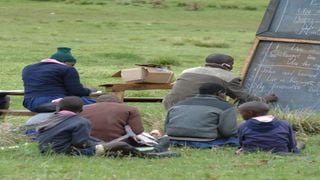
Standard Eight candidates at Timoo Primary School in Mariashoni, Nakuru County, during an English lesson in this photo taken on October 19, 2020. The learners were taking their lessons in the open after 10 temporary classrooms were vandalised while the roofs, doors and windows of four other permanent classrooms were also stolen by unknown people.
|News
Premium
Covid-19 exposed rich-poor divide in education sector
What you need to know:
- Many well-to-do families educate their children in high-end private and international schools.
- The disruption caused by the nine-month closure of schools locked the children of the poor out of the education system.
The divide between the rich and the poor in the education sector has always existed, but it has been accentuated by the Covid-19 pandemic.
The virus has brought to the fore the wide gap that also makes it difficult for children from poor backgrounds to compete on an equal footing with those from well-to-do families.
The majority of Kenyan children in primary and secondary schools belong to the first category.
They also happen to attend public schools, with their attendant challenges to deliver quality education. Many well-to-do families educate their children in high-end private and international schools, to give them a head start in life.
The disruption caused by the nine-month closure of schools locked the children of the poor out of the education system. It is expected that they will suffer most from loss of learning by the time classes resume.
Public schools have struggled to introduce measures to ensure learning continues because of poor funding from the government.
While many private schools embraced technology to teach and learn virtually, the best that the Ministry of Education could muster was the radio and TV lessons offered by the Kenya Institute of Curriculum Development (KICD). The institute also has learning materials available on the Kenya Education Cloud.
Although welcome, the programmes can never achieve what face-to-face interactions between teachers and learners do. Also, many learners have been unable to access them because of lack of radios, TV sets, electricity and the high cost of Internet data bundles.
An attempt by the ministry to introduce community-based learning flopped after a parent went to court to block it, seeking orders to have the government reopen schools. He won the case days after a decision had already been made to do so.
While schools will officially open for second term on January 4, the Nation has established that quite a good number of the private ones that have been teaching virtually have already covered curriculum content for the whole year.
They will, therefore, have enough time for revision or proceed to the next year’s work as the public schools go through a crash programme to make up for lost time. This will definitely have an impact on the learning outcomes.
As the Ministry of Education kept shifting the reopening date for schools, parents and other stakeholders were desperately raising red flags that many learners might not resume learning when schools finally reopen.
It is expected that there will be massive dropouts when teachers mark the attendance registers in January.
Girls have been most disadvantaged by being out of school for the nine months. Many have been forced into early marriages while others are pregnant and some have given birth. Majority of them happen to come from poor backgrounds, and have not been engaged in organised learning activities to help keep them out of harm’s way.
Inadequate preparations
“Schools have been shown to be the best corridor for pupils to be able to achieve their full potential. It is our strong belief that children should be in the school corridor for their safety and development to enable them to achieve their full potential for the economic development of this country,” Dr Patrick Amoth, the acting director-general for Health told the Nation.
The inadequate preparations in public schools to adhere to Covid-19 guidelines issued by the Ministry of Education have caught the attention of the public. Public primary schools will scarcely comply with the strict guidelines as the same entity that issued them has not disbursed any funds for Covid-19 intervention to schools.
Many of the schools do not have clean running water, hand washing points and enough toilets. Education CS George Magoha has admitted that social distancing will be a challenge because many public schools are congested. He has also been non-committal over government provision of facemasks to learners.
As schools reopen, it is not expected that much will be done to improve public primary schools’ — which have an enrolment of more than eight million learners — adherence to Covid-19 protocols.
This is in sharp contrast with many high-end private schools which had most of these requirements in place even before the pandemic. Class sizes in these schools average between 25 and 30 with enough spacing in the classrooms
International schools have also been allowed to reopen in January and many of the challenges public schools face are alien to them.
Learners and staff at Brookhouse in Nairobi, for example, were earlier instructed to do a Covid-19 test 10 days before reporting to school.
They must also undertake “appropriate self-quarantine for 10 days prior to the reopening of school. This includes avoiding all social and public gatherings of people,” according to a return-to-school handbook published by the school.
Each learner will be provided with a safety pack containing branded facemasks, sanitiser and information on Covid-19.
The school has stipulated staggered arrival and pick-up times to minimise physical interactions, something not possible for learners in public schools who have to use matatus.
As public schools shop for hand-held thermal guns, learners in some private schools have been issued with a unique QR code that records their temperature and sends it to a central analysing device and also to their parents’ phones.





